






| THE Gear that made (and still makes) it all HAPPEN |
 |
 |
 |
 |
 |
 |
 |
||
| Guitars | Strings | Pickups | Easy-Mute | Drum Echoes | Tape Echoes | DSP Echoes |
| * THE Amplifiers ..... |
 Several pedantic technical articles exist, more accurately defining the AC30 as a Class AB(1) amplifier. It is not our mission to highlight or debate this contention. |
 GZ34 Heavy Duty Power Rectifier Tube (used in the AC30/x series) |  EF86 Pentode Preamplifier Tube (an unacceptably microphonic device used in the AC30/4) |  ECC83/12AX7 Twin Triode Preamplifier Tube (a more docile device which was used in the AC30/6) |  EL84 Pentode AF Output Tube (common to all AC30s) | ||
| These universally available thermionic valves were the main ingredients in the VOX recipe for successful guitar amplification | |||||
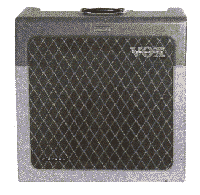 |
The VOX AC15 - the original VOX Amplifier ..... The first product of the newly (mid-1957) incorporated Jennings Musical Industries (J.M.I.) was the Dick Denney designed 15-watt AC15 (Amplifier Combination 15-watts), which was in production by early 1958, featuring a cream-tan cabinet finish, brass ventilators, black control panel with gold legend, ordinary luggage grade leather handles with steel end-caps, and an entire front panel covered in speaker cloth. The unit shown to the left is an unusual "two-tone" model which is indicative of early production changes and "limited editions". The AC15's smaller siblings - the AC2 (fitted with a 6" speaker), soon to become the 8" Elac speaker equipped AC4, and the 10" equipped AC10 (made in single and twin speaker versions), were similarly configured. |
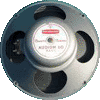 Goodmans Audiom 60 | Originally, AC15s were equipped with a single 12" Goodmans Audiom 60 speaker (left). Subsequently the Rola-Celestion G12 (right) was tried, giving superior results for guitar, but it was less reliable for more demanding bass guitar or organ use. | 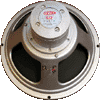 Rola-Celestion G12 |
The VOX AC15 - post 1958 ..... From late 1958/1959 onwards VOX AC15s (and their smaller siblings) featured a top strip of covering material above the distinctive VOX diamond patterned speaker cloth. This new "classic" design would continue on into VOX's later generations of products (including the yet to be announced and now ubiquitous AC30), although the colour of the covering material was to subsequently trend towards black. The Shadows reputedly acquired AC15s in mid-1958, seeing them as affordable and effective units capable of producing the sound they were seeking, although The Shads popularity and their demand for louder equipment for the larger venues they were progressively encountering, would lead them to accept the larger and heavier AC30s which VOX were to develop in response to market forces. |
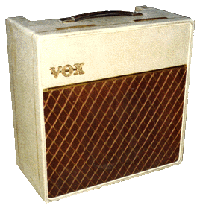 |
 Heritage swing-tag |
 |
The VOX AC15H1TV Hand-wired Heritage Re-issue ..... 2007 marks the 50th Anniversary of VOX guitar amplifiers, and a Heritage Collection of hand-wired units has been released onto the world market to mark this auspicious year. The AC15H1TV is a limited edition AC15 with a Baltic Birch plywood cabinet and special cream anniversary vinyl covering. The company claim is that "the search for the Holy Grail of VOX tone ends here". Combining the prized EF86 pre-amp channel of 1958 with the Top Boost channel of 1963 all in one unit, and boasting modern tone shaping enhancements - the AC15H1TV is arguably the finest VOX amplifier ever produced, in the company's amazing 50 year history. A Celestion VOX "Blue" Alnico speaker is included in this unit as standard, with a VOX instigated "Triode/Pentode" switch enabling the user to halve the power output down to a very docile 7.5 watts. |
|
  |
| . Enter the AC30 - a major "point of reference" in the definitive sound of 60s British Rock Music ..... | |
| The VOX AC30/4 a.k.a. VOX AC30 Twin ... Utilising AC15s at the time, The Shadows became aware of the new 60-Watt Fender "Twin-Amp" with it's dual 30-Watt Jensen speakers, and they asked JMI the question .... Why not a "twin" AC15? Dick Denney's ultimate response was the AC30/4 which featured a quad configuration of EL84s, a larger power transformer, heavy-duty GZ34 rectifier and two specially toughened 12" 15-Watt Celestion G12 speakers. In late 1959 The Shads took delivery of their first three AC30/4s, and thus was born THE amplifier which was to categorise the British "beat sound" into the 60s and beyond - to this very day. Quite soon, Celestion design engineer Les Ward stiffened the cone of the G12, restricting cone movement at higher power, increasing efficiency and reliability in both bass and lead - the redeveloped speaker becoming known as the VOX "Blue". A 1963 Beat Instrumental advertisement lists the AC30 at £110.00 |
 |
     |
 |
The VOX AC30/6 a.k.a. VOX AC30 TB ... 1961 saw the implementation of some changes to the AC30/4 design. The excessively microphonic and vibration susceptible EF86 pentode pre-amp tube was replaced with less costly and more docile ECC83/12AX7 twin-triode pre-amp tube. This twin-triode tube permitted the addition of a third "brilliant", or specialised "lead guitar" channel which closely emulated the sound of the AC30/4's pentode driven architecture. Available as an additional piece of circuitry which could be added to AC30s as an extra, it was also available factory installed and the unit was known as the "Top-Boost" or "Brilliance" model. In 1964 the Top-Boost circuitry was incorporated into a suitably revised AC30 chassis, and was distinguishable but the addition of two extra tone controls on the upper control panel. Super Twin (separate amplifier and cabinet) model development is of little significance here. |
| Click to enlarge this VOX advertisement which features Hank and The Shadows (circa 1964) (Thanks to Brian Watters) |
 |
||
 Rola/Celestion Original VOX G12 "Blue" |
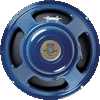 Celestion Alnico G12 "Blue" |
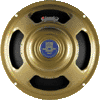 Celestion Alnico G12 "Gold" |
 Celestion Heritage G12M "Greenback" |
 Celestion Heritage G12-65 High Power |
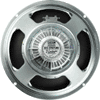 Celestion Classic G12-60 Century Vintage |
||
| · Original and re-issue Rola/Celestion/VOX speakers covering a wide range of applications · |
|||||||
The VOX AC30CCxx Vintage Re-issue ... Since Korg's acquisition of VOX's intellectual properties, a superb series of re-issue versions of various AC series amplifiers has emerged, and 2004 saw the introduction of the AC30CCxx (for Custom Classic) series. This series is comprised of the AC30CC1 (1x 12" combo with a custom voiced VOX NeoDog speaker), the AC30CC2 (2x 12" combo with a pair of custom designed GSH12-30 speakers), the AC30CCH (Head Unit: with either of the following cabinets - V212BN1 with 2x 12" GSH 12-30 speakers - V212BNX with 2x Celestion "Blue" AlNiCo speakers - V412BN/BL 4x 12" cabinet with 4x GSH 12-30 speakers), and perhaps the most popular example, the AC30CC2X which features blendable channels (Top-Boost and Normal), spring reverb, external FX loop, global tremolo, a very desirable master volume control, and of course Celestion "Blue" 15 watt AlNiCo speakers as used in the original VOX AC30 Combo. This amplifier (a glowing tribute to Dick Denney's designs), drawns on the legacy of it's predecessor which made its debut in it's original form in 1959, and is now totally redefined with a plethora of new enhancements, but includes all the original features which have constituted the sound of British Rock for over 45 years — a sure-fire hit with Shads fans and would-be Hank-a-likes ..... |
     |
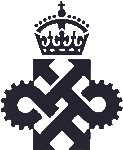 |
The Queen's Award to Industry 1967 ... "Her Majesty The Queen has been graciously pleased to confer Her Award in 1967 upon the following industrial concerns in recognition of their efficiency, as demonstrated by outstanding achievement by the industrial units cited in increasing exports or in technological innovation, or both." So commenced the citation for this prestigious award to Royston Industries for the achievments of Jennings Musical Industries Limited. J.M.I. had (the previous year) exported over £750,000 worth of musical equipment to more than 70 countries. |
||
 |  |  |
 |
Cliff and the Shadows — The Final Reunion ... For the "Final Reunion Tour", Hank and The Shadows used JMI (VOX clone) amplification — JMI (Jennings Musical Industries) owned the VOX brand, and and manufactured instruments and equipment from it's factory in Kent, UK. As is very well documented, the VOX brand changed hands on several occasions, eventually winding up within the multi-national Japanese KORG organisation. Amongst the "windings" (pun fully intended!) JMI was revitalised, and although no longer owning the VOX brand, reputedly still had some kind of access to the original circuitry. In recent times JMI, HiWatt UK and Orange have been subsumed into the Music Ground (Leeds, UK) organistaion, a major force in the vintage instrument scene with retail stores in Manchester, Leeds and several in Denmark Street, London. In late March 2010 after weeks of rumour and speculation, Music Ground closed in the face of the appointment of a liquidator. |
 |
| * THE Guitars ..... Go to top of page |
 |
Clarence Leonidas (Leo) Fender 1909 - 1991 — Founder of the Fender Electric Instrument Company — Leo was the "father" of the legendary Fender Stratocaster – undeniably the world's most popular, and most imitated guitar |
|
| THE Fender Stratocaster ..... Leo Fender's principal legacy to the music world was the enduring Fender Stratocaster. Loved and respected across the planet, it remains the defining feature of an amazing number of musical genres. The instrument shown to the left is my Fiesta Red Custom Shop Replica of a '57 Stratocaster, in deference to Hank's original Stratocaster (#34346), with maple fingerboard and gold hardware, retro-fitted with (now discontinued) Kinman HX Pickups, whilst the instrument to the right is my Fiesta Red '62 Vintage re-issue (V-series) Stratocaster which has been retro-fitted with Kinman CV-HMS Pickups. Both of these quite superb instruments are "vintage" re-issues of definitive era examples and were manufactured by Fender in the USA. Take this opportunity to read George Geddes's priceless "Sound of Hank" article for an in-depth commentary on Hank B. Marvin's sound, and his acquisition of Britain's first Fender Stratocaster - the famous Serial #34346. Click here for a vintage Stratocaster wiring diagram |

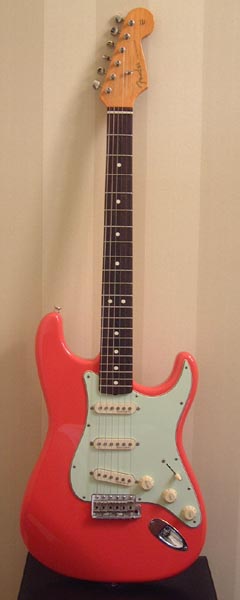 |
   |
| James Ormston (Jim) Burns 1925 - 1998 — Founder, innovator and driving force behind Burns Guitars — Jim was often described in the business as the "British Leo Fender" - a man whose ideas have been extensively copied by larger manufacturers |
 |
|
 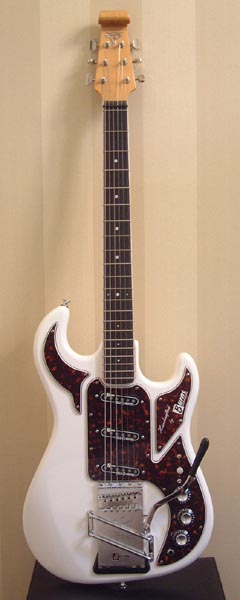 |
The Burns Marvin ..... When The Shadows "temporarily" changed guitar brands in November 1963 their new choice was for Burns. Hank and Bruce are credited with having huge input into the design of the new Burns instruments, but even so, Bruce's and Hank's apparently had slightly different pole spacings and pickup positions. The production Burns Marvin is quite distinctive with it's scrolled headstock and extremely elaborate vibrato arm, vibrato suspension system and "REZ-O-MATIC" pickups. The advent of Burns instruments heralded a whole new sound era for The Shadows. The Shadows used Burns guitars up until 1969, and again in the later Marvin, Welch and Farrar era. In 1971, all their Burns instruments were stolen and were never recovered. Only 300–350 Burns Marvins (my own instrument - Serial #9788 is shown to the left) were made in 1964-65 and these are now highly prized by collectors (the instrument to the right is my 40th Anniversary Re-issue Marvin - Serial #0022). According to Burns promotional material the "Marvin" had a body width of 12½", a scale length of 25½", was finished as standard in White, and cost £162-15-0 (the luxury case was an additional £14-14-0). |
| * Strings Go to top of page | ||
 |
In the letter to the left, Hank is indicating the string gauges he was utilising in the early 60s when the Shadows' classic hits were recorded. At the point this note was written, Hank was actually touring as a solo artist, and he indicates his gauge choice for best delivery of his oldies, at that time. The Cliff Richard and The Shadows "Final Reunion" Worldwide Tour is now complete, and Hank was utilising two Custom Shop Stratocasters. One was fitted with 11-49's, and the other with 12-52's which is entirely consistent with his previous indications. "Why two guitars?" - you may well ask, and Hank will probably respond "... because I can ..... but the real reason is to deliver the most original sound possible for the benefit of the fans !". Hank almost certainly used a wound G-string on the Strat fitted with 12-52's, and bending that set is a major mission, so he can be forgiven for choosing lighter strings (with a drawn G-string) for the later numbers - sore fingers not an option. | |
| * Kinman noiseless pickups (pups) ..... R-evolutionary ..... ! Go to top of page | ||
| Kinman noiseless pickups (pups) ..... Chris Kinman has been a pickup designer/maker for many years and after 16 years of passionate research and development he perfected pickups for Fender Strats, Teles and similar guitars (using 6 Alnico magnets) that sound and look exactly like the 1950's originals but which are absolutely noise-free - and they work with original 250K ohm potentiometers! Chris's AVn Pickups have the tracking ability, expansion, expression and air (wide dynamic range, rapid attack, presence, bite, sensitivity and resonance) as well as the genuine Alnico tone of genuine single-coil originals, BUT they have no mains frequency hum (noise). These pickups are truly R-evolutionary (to use Kinman's promotional slogan) and are covered by various USA Patents, the latest of which Kinman was granted in August 2000. |
 |
|
| Visit Chris Kinman's super-informative Website at http://www.kinman.com and buy direct from his on-line shop | ||
 (All images originally from Chris Kinman's Website). |
Hank B. Marvin uses Kinman Noiseless Pickups ..... to achieve his silky smooth sounds without mains hum or noise. Six of my own Strats are fitted with Chris's Pickups – a USA Custom Shop '57 Vintage Replica in Fiesta Red and Gold (HX pups), a USA '62 Vintage Re-issue in Fiesta Red (CV-HMS pups) with VML Easy-Mute Tremolo Arm, an "MIJ" '93 in Fiesta Red (AVn Traditional pups) with Graphtec FerraGlide Saddles, a USA '57 Vintage Re-issue in 2-colour Sunburst and Gold (AVn Traditional pups), a USA Custom "All Black" '62-style (AVn Traditional pups) with Wilkinson Bridge, and a '62-alike Stratocaster in Fiesta Red (slight relic) (FV-HMS pups - K9 Switching). |
 |
|
| AVn = Authentic Vintage noiseless | |||
| * Easy-Mute Tremolo Arms ..... Go to top of page |
| The VML "Easy-Mute" Tremolo Arm was designed by Ian St. John White, and has been refined and developed in conjunction with Hank over several years. Available in polished stainless steel or gold plated, arms can be supplied with US (10 x 32 tpi UNF) or M5 Metric thread. They are available for either right or left-handed use, and 3 standard lengths are available: 110mm – The "Signature" version, which replaces the arm originally fitted to Hank’s signature Stratocaster. 130mm – the version which Hank now uses, and which is the most popular length. 155mm – the version which replaces the standard length arm, as fitted from the Factory. A deluxe aluminium knob is available in silver or gold anodised finish. VML also does "Total Tension" modifications to tremolo blocks. |  VML Easy-Mute Tremolo Arms |
 VML Easy-Mute Tremolo Arm in gold |
 Ian St. John White and Hank |
 Hank practicing |
 Easy-Mute equipped guitars on tour |
| * Drum-based Echo Units ..... Go to top of page |
 |
| A signed publicity shot of the man who didn't like the sound of his Meazzi echo unit - and thus decided to pass it over to our Hank !! |
| The Jennings Meazzi Echomatic 1 Many thanks to Bill Jones for a couple of really nice images of the ledgendary Meazzi Echomatic 1 (in it's incarnation as a Jennings rebadged unit for the UK market). With all it's magnificent "stunt incidental tones" - this echo unit is arguably the most significant and defining factor in the classic original Shadows' sound. |
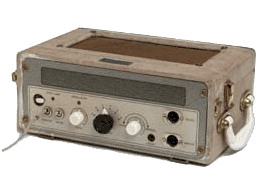 |
| The Jennings label .... An enlarged version of the Jennings label, visible on the Jennings branded unit above. |
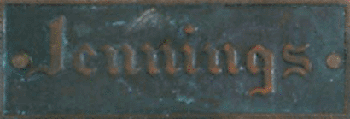 |
 |
The Jennings Meazzi Echomatic 1 .... unmasked A top view of the unit (with the removeable top cover taken off) ... showing the echo drum with the various record, playback and erase heads, associated interconnection circuitry and valves. |
| The VOX Echo Meazzi Echomatic 1 ..... Here we have an extremely "grainy", side-on image of the original "Holy Grail" of echo boxes from The Shadows golden era - this is the wondeful Meazzi Echomatic 1, in this case rebadged as a VOX Echo, whilst the subsequent higher quality images show front and top shots of a slightly modified VOX Echo (again a rebadged Meazzi Echomatic 1 unit), where two extra controls have been added on the ventilation grille panel. |
 (Thanks to Ade for this image) |
 |
 |
 |
The Binson Echorec Baby ..... Binson echo machines were originally introduced in the late 1950's. This example - the so called "Baby Binson" was reputedly Hank's "standby" unit. It (like it's VOX and Meazzi couzins) featured a "memorydisk" which had a magnetic band around the edge. These units required responsible care and attention due to the nature of the head/disk interface, and were likely to be problematical if continually used without regular cleaning and lubrication. It is well documented, however, that if well cared for, they were quite capable of providing many many years of good service - and of course excellent sound enhancements. Well cared for units are reputed to be still operating after 50 years. |
| A Binson Mechanism ..... The mechanism shown is that of the Baby Binson, consisting of a 3 inch recording disk, driven by a rubber-rimmed jockey wheel which is itself driven by a powerful AC electric motor - making for a very stable transport system. Situated around the disk are the record head, 4 replay heads and an erase head, all of which are in constant contact with the recording medium on the edge of the disk. The longest echo time available from this system is of the order of 350 to 375 milliseconds. |
 |
 |
The Binson 2 Mechanism ..... Almost the same as the previously shown mechanism, this big brother featured a 4 inch recording disk which allowed longer delay times to be selected. Thanks to David Jeffreys of Magitec Ltd. (UK) for many of the rare Binson and other related digital images presented on this page. Binson units were also OEM'ed to other brands such as Sound City, Guild and EKO. Other models of similar overall configuration/performance were B1, Echomaster 1, T5, T5E and of course the previously shown Baby. |
| The Binson Echorec 1 and 2 ..... Later generations of Binson units feature a larger (4 inch) "memorydisk" which was capable of producing much longer delays than it's older sibling. The Echorec 2 (not shown) is heard on the 1964 studio recording of "The Rise And Fall Of Flingel Bunt" where the 5th head "answers back" prominently. |
 |
 |
The Binson Echorec 6 ..... The advent of the T7E and the Echomaster 2 saw the introduction of hybrid (valve/transistor) circuitry. As well as a 19" studio machine (the PE603 TU), there was also a fully transistorised model 603. Hank is reputed to have acquired an Echorec 6 when The Shadows reformed in the 1970's. Despite it's formidable potential with it's 6 individually selectable heads, the unit suffered from a terrible hiss and was therefore promptly kicked into touch. |
| * Tape-based Echo Units ..... Go to top of page |
| Meazzi PA 306 Echomatic ..... An original six-head tape echo unit, which superceded the previously very successful drum-based units, and one which spawned a generation of Shadows fanatics. This valve-based tape echo system was manufactured in Italy by Meazzi in the early 1960s. |
 |
 |
The Meazzi Echomatic ..... Meazzi's 6 replay headed tape-based echo system. The first 4 replay heads were individually selectable by switches which provided excellent flexibility of echo selections. Meazzi echo units were manufactured in Italy.  |
| Meazzi Factotum Special ..... One of the later generation of tape-based units still highly prized by continental Shadows sound-alike groups. This mono, valve Factotum featured 6 playback heads and was an extremely versatile unit with a wide range of echo sounds. It was superceded by an all transistor mono version, and subsequently by the Model 440 Factotum, which was an all transistor stereo unit. |
 |
| Charlie Watkins - British father of the tape echo ..... With the very first "Copicat" - back in his hands after more than 40 years, a spritely Charlie Watkins muses that he sold this unit (he made the first 10 in his little old shop in Balham High Road, South London in 1958) by responding to Johnny Kidd's pressures to sell him "one of 'vose cat fings guv'nor" and letting Johnny (real name Frederick Heath, born 23.12.1939 in London - already with the patch over his eye at that stage) buy the very first unit. That started it all, and after about six months Charlie had enough money to buy his first factory at 66 Offley Road, London, SW9. I've had a few telephone conversations with Charlie and he's a very interesting old cove - with a sentimental connection to Christchurch, New Zealand from his days as Abel Seaman Charles Watkins in the British Merchant Navy. Charlie wrote me a letter which said that "Forward to the 60s" is his war cry now ! |
 |
 |
 |
 |
| WEM and The Famous Copicat Logo ... In Charlie's own words ..... "Our most spectacular contribution to that era was, of course, the Watkins Copicat Echo Unit. This little unit was snapped up by the forward looking, along with sound hungry guitarists of the day, and it achieved the status of the 'missing link' in the originating chemistry of legendary '60s music ....." Considered today as a world industry standard, the modern Copicat is (not entirely surprisingly) miles in advance of the original little units that Charlie lovingly built with his own hands (but minus the nostalgia, of course) ............ |
|||
| The Watkins All-valve Original Copicat (Mark I) ..... Although never utilised by the Shads, the Watkins "Copicat" is credited with being the first tape-loop echo unit. The original "Copicat" Mark 1 was designated as an "Echo and Reverberation Effects Unit", and was produced in a blue and white livery (as shown to the right). Featuring 3 playback heads (individually selectable), seven distinct echo combinations, nil to extreme "reverberation" on all combinations, and a permanent magnet (in the tension arm) as an erase head. |
 |
 |
The Watkins All-valve Copicat (Mark II) ..... The Mark II had a black and white panel (as shown to the left) and it sported exactly the same features as it's earlier predecessor. Local Christchurch guitar hero Max Merritt had one in the very early 60s - his was the first I ever saw (and heard live), but I can't be sure which particular model it was. To acquire one in New Zealand in those days, required access to a designated proportion (actually one third) of the purchase price in overseas funds to qualify for the necessary import licence - known as a "No Remittance Licence". The 1960s price was £38-10-0 as evidenced by the product image. |
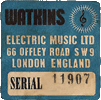 |
These early machines were quite reliable, although the phosphor-bronze bearings of the shaded pole tape-drive motor were inclined to slop out with continued use. Inevitably one would have to splice one's own tape loops, and with the stretch provided by the spring-tension, a gap would open at the splice, and the classic thump thump .. thump .. would occur as the gap passed the head(s) on each rotation of the tape !! |
| The Watkins "Custom" Solid-State Copicat (Mark III and Mark IV) ..... A lower profile unit with a larger footprint than their predecessors, the Mark III amd Mark IV Copicats were fully solid-state and featured the same 3 individually selectable playback heads as their famous predecessor. Although more successful than the original Copicat the latter-day version was never to be held in the same high regard as the original Copicat, and accordingly is less sought after by collectors. The tape transport system was essentially the same as the Mark I and Mark II Copicat, utilising a shaded pole motor, and with tape-tensioning again achieved by a sprung arm with integral permanent magnet erase head. |
 |
 |
The Watkins Copicat Super Shadow ..... A 5-head, hybrid (valve/solid-state) design with low noise and excellent performance, the Super Shadow model was introduced in the late 80's. Again it features individually selectable heads (in this case four), but also has a continuously variable speed drive motor, which allows for an extremely wide selection of echo combinations in conjunction with the head selections. The unit is similar in style and size to the original Copicat, but with a single (as opposed to the original split or 2-piece) lid. Note the distinctive Watkins style compartment for the power lead - carried over from previous Copicat designs. The Output and Footswitch jack sockets are only accessible only via this compartment (practically, not such a crash-hot design feature I have to say). This particular unit came directly from Charlie Watkins for my own collection. Sadly it hasn't had much use for the past several years. |
| The Watkins Copicat Super Shadow again ..... A refined version of the previously shown "Super Shadow" model. This time the Output and Footswitch jacks are repositioned onto the front panel (on the lower right hand side, next to the oblong ON/OFF switch). The front panel (screen printed in two colours), completely covers the area formerly used for Power Cord and Footswitch storage to the left of the unit. All other features are unchanged. |
 |
 |
Click to enlarge this excerpt from a VOX Reverb and Echo brochure (circa 1964) (Thanks to Brian Watters) |
||
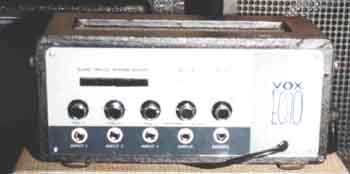 |
The VOX Echo (Shadows Model) ..... The 3-head VOX Echo (marketed as the Shadows Echo) was one of the first tape-based echo systems available on the UK market in the early '60s through J.M.I. Contrary to the popular folk lore and publicity of the time, and despite the Shadows' endorsement, these units were reputedly never used by The Shadows. |
| The VOX CO2 a.k.a. The Long Tom ..... A 6-head, extended loop version of the original VOX Echo. Being longer physically, and having been designed by Dick Denney the unit became known within J.M.I. as the "Long Dick", however sensibility saw the unit appear in the market place as the "Long Tom" after Tom Jennings (owner of J.M.I.) rather than designer Dick Denney. This is a true story ! |
 |
 The München (Munich) Coat of Arms |
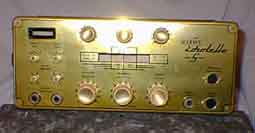 |
The Kelmt Echolette 5 ..... The Echolette 5 employed a 20" tape loop under relatively low tension and was thus very easy on tapes. A two-speed motor, three record heads (each with separate volume control) and two (selectable) playback heads provided a wide variety of echoes. The Klemt Echolette E51, another echo unit with very similar features to the Echolette 5, appears below. |
 |
The Klemt Echolette E51 ..... Klemt echo units were invented by Hans Bauer (a German musician), and were manufactured in a small tape recorder factory KLEMT in Ochling near München (Munich) in southern Germany. Echolette and Dynacord (producers of the "Echocord" line) joined forces in 1969. (Thanks to Roelf Backus for this information) |
| Roland Space Echo Series ..... ..... from Roland Corporation which was established in Osaka, Japan in 1972 by Ikutaro Kakehashi. Starting with the RE-100 (not shown), other models included the RE-101, RE-150 (both stripped-down models with no reverb and no EQ), and the RE-200 (also not shown). These models were precursors to the release in 1974 of the most famous of the Space Echoes, the Roland RE201 - an instant hit, which remains an industry bench-mark item to this day. The RE201 Space Echo was hugely successful and remained in the Roland catalogue for the next 16 years ..... right up until 1990. |
 |
 |
 |
 |
Roland RE201 - the most famous of the Space Echoes ..... The RE201 (show immediately above) was the last Space Echo. The picture to the left shows a "lid-off" view of the tape transport system, which utilised a tape cartridge, which Roland refers to as a Tape Pack. This allowed the tape to be easily deployed into the top holding bay. The extended tape loop had the distinct advantage of not having a splice pass the record head so frequently, and accordingly the "splice thump" of most other tape echo units was virtually undetectable. |
| A Roland Digital Space Echo — The RE3, was launched onto the market in 1988 ..... although very impressive and highly specified, it was not a great success ..... |
| ..... a new enhanced series of echo units - the Roland Chorus Echoes ..... |
 |
Roland RE301 Chorus Echo ..... The RE301 used the same tape transport as the RE201 - a system which improved sound quality and prolonged the useful life of the tape itself. It's combination of reverb, multi-tapped echo, sound-on-sound, chorus and EQ proved attractive to guitarists, vocalists and keyboard players alike. |
|
| Roland RE501 Chorus Echo ..... The RE501 and it's big brother, the top-of-the-line rackmount SRE555 still continued with the same tape transport and tape deployment system as their predecessors, and included the now standard chorus and sound-on-sound, but additionally they packed a fourth echo head and a balanced (XLR) input. |
 |
|
 |
The Roland SRE-555 (Rackmount) ..... |
| * All those echoes in one box ..... ! Go to top of page | ||
| With the advent of the digital era, a new style of echo system has emerged. Made possible by the use of Digital Signal Processors and powerful ancilliary solid state devices, these systems allow the sounds of original echo units to be emulated to an amazing degree, and of course Hank has taken full advantage of this technology in order to deliver unbelievably authentic sounds on the spot and live. The following information attempts to present an overview of the two systems Hank has most recently utilised for studio recording as well as touring engagements ..... | ||
Alesis QuadraVerb 2/Q20 with Echoes From The Past ..... |
 |
 |
The amazing Alesis Q20 Professional 20-Bit Master Effects Unit ..... Utilising an exclusive 24-bit Alesis DSP chip which can produce up to 8 programmable effects, and employing greatly expanded internal memory, the truly amazing Q20 allows choices between more than 50 different effects types for each of the 8 available programmable blocks, including hall, room and plate reverb, graphic and parametric EQ, flanging, chorus, pitch shifting, delay, rotary speaker simulation, overdrive, auto-panning with Doppler effect, stereo sampling, and many more. 20-bit digital converters provide spectacular frequency response, wide dynamic range, and ultra low distortion, and in addition to analogue inputs and outputs, the Q20 accepts and transmits digital audio utilising Alesis's proprietary ADAT Optical or S/PDIF protocols ...... |
|||
| A major point of concern with a Q20 programmed with the EFTP suite of program patches is that all units are intrinsically "neutered" by EFTP (i.e. the unit's MIDI output circuitry is destroyed) prior to shipment — this to prevent owners doing a SYSEX dump for prudent back-up purposes. The neutering process places one's Q20 in an extremely vulnerable state, as User Program information is volatile, and is ultimately retained in the Q20 only at the behest of an on-board BR2325 lithium cell (which is factory-soldered into the Q20's motherboard). Programmed information is safe whilst AC power is available to the unit, but when the Q20 is unplugged, the lithium cell is in a "count-down-to-oblivion" or "I'm-going-back-to-the-UK-to-see-Charlie" mode. Unsoldering the lithium cell and installing a new one whilst power is applied is possible, without loss of the program information, but it is definitely not a job for the faint-hearted. My own solution to this problem (after fighting a severe case of advanced paranoia) is/was to install a removeable lithium cell inside the Q20 with EFTP. This allows extremely easy battery changes with power on, and is a most effective insurance policy - especially if you happen live right at the antipodes ! | ||||
 |
Hanks Touring Echo Rack ..... These days Hank B. Marvin chooses to ensure his trademark echoes are totally authentic by utilising Charlie Hall's amazing Alesis-based "Echoes From The Past" echo system. The image shown to the left is of Hank's original EFTP-based Touring Rack, which featured two Alesis Q2s - one for regular use and the other just in case that evil little Mr. Murphy happened to be snooping around. Hank's rack has subsequently been upgraded to include a pair of state-of-the-art, latest and greatest, Alesis Q20s with enhanced EFTP patch versions, making full use of the Q20's greatly extended internal memory capacity. |
| TVS Specialty Products ..... The TVS (Tape Voicing Systems) line of sound processors has emerged from a number of years of research into the characteristics of original tube-based tape echo units (such as the famous Meazzi Echomatic series), which were of course distinguished by a warm, singing quality that, up until now, has not been available from modern day solid state emulations of these units. |
 |
| The TVS3 Echo System ..... Unlike other analogue echo units currently available, the TVS3 offers complete programmability of the echoes. Up to 100 patches can be stored. The unit is supplied with 30 patches already installed, and these cover all of the operating modes of the original Meazzi Echomatic 1 and 2, as well as some Binson, Echoplex, Roland Space Echo and Echolette modalities. Updates are provided for additional patches as they are developed in response to user feedback. Modification of the patches or programming of new echoes is via a serial link to a PC or laptop using a supplied program. A pedal allows remote patch selection and patch pre-selection using up, down and load footswitches which replicate exactly the push button functions on the front of the TVS3 — a large LED display indicating the patch selected, and an additional blinking high-intensity LED can be enabled to indicate patch pre-selection. |
 |
 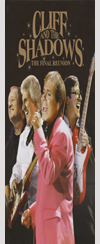  |
|
| Hanks Studio Setup ..... and out there on tour 2009/2010 Hank is fully aware that the TVS line of echo systems provides an unbelievably accurate emulation of original tube-based echo units such as the famous Meazzi Echomatic series, and not surprisingly, he's taken full advantage of the opportunity to use these units to deliver a totally original recreation of his famous 60s sounds, on tour and in the studio. The image to the left shows Hank's studio rig (with 2 TVS3s + a Q20). Recently in Guitar and Bass Magazine, Hank talked about his "Guitar Man" CD and said of the TVS3 ..... "I've used a couple of echoes. A local (Perth, Western Australia) guy called Paul Rossiter has developed an analogue echo using all the old circuitry. It really has those early 60s sounds I used to get". MORE! Paul has recreated most of the classic echo sounds to be found on 60s vinyl records ... |
|
| – Hank utilised the TVS3 on the Cliff and Shads "Reunited" CD, and during the course of the "Reunited" Tour – | |
| Ever wondered about the exact specifications for 19 inch rack equipment ? | |
 |